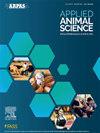Evaluating the effects of acidosis and bacterial inoculum concentrations on the development of liver abscesses in beef × dairy steers
IF 1.5
Q3 AGRICULTURE, DAIRY & ANIMAL SCIENCE
引用次数: 0
Abstract
Objective
We evaluated the association of diet type, ruminal acidosis bout frequency, and intraruminal bacterial inoculum concentration on liver abscess (LA) development in steers.
Materials and Methods
Beef × dairy steers (n = 40, initial BW = 107 ± 11 kg) were assigned randomly to 1 of 5 treatments that included intraruminal inoculation of either a high dose (HD; 100 mL of 1 × 108 and 100 mL of 1 × 109 cfu per steer) or a low dose (LD; 100 mL of 1 × 106 and 100 mL of 1 × 107 cfu per steer) of Fusobacterium necrophorum ssp. necrophorum and Salmonella enterica serovar Lubbock, respectively. Treatments included the following: NCON = high-forage diet with no bacterial inoculation; CON+HD = high-forage diet with a single HD inoculation; 2AD+HD = 2 acidotic diet cycles with a single HD inoculation; 4AD+3LD = 4 acidotic diet cycles with a series of 3 LD inoculations; and 4AD+HD = 4 acidotic diet cycles with a single HD inoculation. Steers were slaughtered 21 d after the last bacterial inoculation. Animal was the experimental unit. Continuous data were analyzed using mixed models, and categorical data were analyzed as binomial proportions with treatment, time, and their interactions as the fixed effects.
Results and Discussion
Incidence of LA were 0%, 37.5%, 37.5%, 50%, and 12.5% for NCON, CON+HD, 2AD+HD, 4AD+3LD, and 4AD+HD, respectively, but the difference among treatments was not significant. Although no difference was observed in rumenitis among treatments, steers with LA presented rumenitis scores that were 8 percentage points greater than steers without LA. Steers consuming the high-forage diet also were presented with rumenitis. Hematocrit values were greater in NCON, 2AD+HD, and 4AD+HD than CON+HD or 4AD+3 LD. Similarly, neutrophil:lymphocyte ratio differed among treatments, with a greater ratio for CON+HD and 2AD+HD than for NCON, 4AD+3LD, and 4AD+HD.
Implications and Applications
A key finding of this study was that steers fed a high-forage diet given a high dose of F. necrophorum and S. enterica, even in the absence of the acidotic diet, developed LA.
评价酸中毒和细菌接种浓度对牛乳阉牛肝脓肿发展的影响
目的探讨饲粮类型、瘤胃酸中毒发作频率和瘤胃内细菌接种浓度与犊牛肝脓肿(LA)发展的关系。材料与方法40头牛×乳牛(n = 40,初始体重= 107±11 kg)随机分为5个处理,其中1个处理包括高剂量(HD;每头牛100毫升1 × 108和100毫升1 × 109 cfu)或低剂量(LD;每头牛100 mL 1 × 106 cfu和100 mL 1 × 107 cfu)。分别为necrophorum和enterica serovar Lubbock。处理包括:NCON =高饲粮,不接种细菌;CON+HD =单次接种HD的高饲粮;2AD+HD = 2个酸中毒饮食周期,单次接种HD;4AD+3LD = 4个酸中毒饲粮周期,连续接种3次LD;4AD+HD = 4个酸中毒饮食周期,单次接种HD。最后一次细菌接种21 d后屠宰。动物为实验单位。连续数据采用混合模型分析,分类数据采用二项比例分析,以治疗、时间及其相互作用为固定效应。NCON、CON+HD、2AD+HD、4AD+3LD、4AD+HD的LA发生率分别为0%、37.5%、37.5%、50%、12.5%,但不同治疗间差异无统计学意义。虽然在不同的治疗中没有观察到瘤胃炎的差异,但LA的阉牛的瘤胃炎评分比没有LA的阉牛高8个百分点。食用高饲料日粮的阉牛也出现了瘤胃炎。NCON、2AD+HD和4AD+HD患者的血细胞比容值高于CON+HD或4AD+3LD。同样,不同治疗组的中性粒细胞:淋巴细胞比率也不同,CON+HD和2AD+HD患者的比例高于NCON、4AD+3LD和4AD+HD。本研究的一个关键发现是,饲喂高饲料饲粮的公牛,即使在没有酸性饲料的情况下,也会被给予高剂量的坏死乳杆菌和肠球菌。
本文章由计算机程序翻译,如有差异,请以英文原文为准。
求助全文
约1分钟内获得全文
求助全文

 求助内容:
求助内容: 应助结果提醒方式:
应助结果提醒方式:


